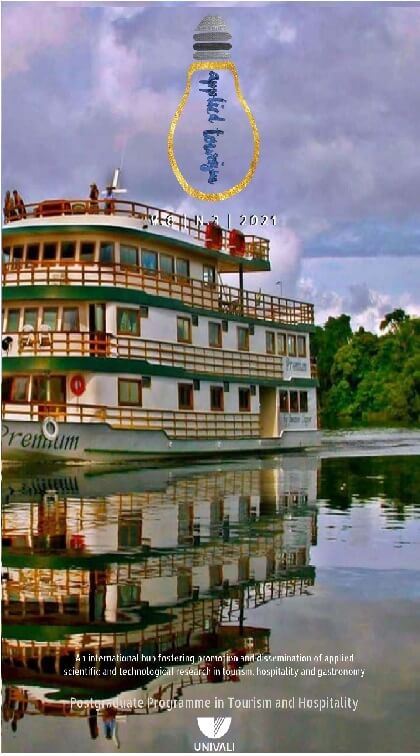

This article discusses the touristic ethnic space in an indigenous community located in the metropolitan region of Manaus. The study is based on the ethnic perspective, as a historical construction of the identity of a specific group of people, a social group that has a different way of life from the urban world. The research purpose was to analyze the absolute, relative and relational space of a touristic indigenous community, pointing out the territorialities that were built from the touristic activity. The methodology was based on an exploratory study, and the geographic constituency was the Sahu-Apé community, in which it was possible to identify not only the functional dimension, but also its symbolic dimension within the space formed by a set of unique symbols of the ethnic group, compared to other groups. For Haesbaert (2004), these mastery constitute the identity and establish the ways in which relationships are built in indigenous societies based on their ancestors. As main results, it was found that the identity of the Sateré people is configured in its most important object in the tourist activity, and the physical and symbolic space is the tourist product that has been built over time.




Amirou, R. (2007). Tourism and post-modernism: the metamorphoses of authenticity. Espaces, Tourisme & Loisirs, (245), 46-53.
Brazil. (2004) Ministry of Tourism. Cultural Tourism: basic guidelines. 3. ed., Brasília: Ministry of Tourism.
Burke, P. (2003). Hibridismo Cultural [Cultural Hybridity].
Canclini, N. G. (2017). Hybrid cultures, oblique powers. Media and Cultural Studies, 73, 422.
Canclini, NG. (2008). Hybrid Cultures. São Paulo: EDUSP.
Carvalho, Joelma Monteiro de. (2015). Tucandeira ritual: memory and cultural tradition of the Sateré-Mawé people. PPGLL UEA. Manaus.
Carvalho, Joelma Monteiro. (2018). Memory and tradition: sacred symbols and religiosity. Vol. 2 Memory and Identities, p. 49. https://cienciadasreligioes.ulusofona.pt/wp-content/uploads/sites/86/2021/07/VOL-2.pdf#page=49.
Carvalho, JM de. (2019). Ritual of passage: from indigenous lands to urban areas of the Sateré-Mawé. Manaus: UEA. http://repositorioinstitucional.uea.edu.br/Acessado in February de 2020.
Coriolano, Luzia Neide MT (1998). From local to global: coastal tourism in Ceará. Campinas, SP: Papirus.
dos Santos, D. M. A., de Carvalho, J. M., & Tricárico, L. T. (2020). Patrimônio imaterial e o turismo étnico em comunidade indígena, em Iranduba, Amazonas. Turismo e Sociedade, 12(3). https://revistas.ufpr.br/turismo/article/view/69779. Acessado em setembro de 2020.
Eliade, Mircea. (1992). The sacred and the profane. [Rogério Fernandes translation]. São Paulo: Martins Fontes.
Gandara José Manoel Gonçalves. Mello Cynthia Menezes. (2019). The exotic and the perfect trip in the photographic figurativization of the tourist destination Curitiba-Brazil. Federal University of Paraná (Brazil) Vol. 17 No 1. Pgs. 81-96. Enero-April. https://doi.org/10.25145/j.pasos.2019.17.006.
Haesbaert, R. (1997). Deterritorialization and Identity: the “gaúcha” network in the Northeast. Niterói: EdUFF.
Harvey, D. (1973). Social Justice and the City. London: Edward Arnold and Baltimore: John Hopkins University Press.
Lefebvre, H. (1991). Formal Logic, Dialectical Logic. Rio de Janeiro: Brazilian Civilization.
Lefebvre, H. (2000). The production of space. Trans. Doralice Barros Pereira and Sérgio Martins (from the original: La production de l'espace. 4th ed. Paris: Éditions Anthropos. First version: beginning.
Lévis-Strauss, Claude. (2014). Myth and Meaning. Lisbon: Editions 70.
Lima, IB; Ismar Borges de Lima; Assis, JNC; Moura, Knr; Lima, Ismar Borges de. (2013). A Contextualized Reflection on the Potential of Ecotourism for a Model of Ethnodevelopment and Social Inclusion in the Indigenous Reserves of Uiramutã and Pacaraima, Roraima. In: 1st Colloquium Tourism in Indigenous Lands: Tourism, identity territories and interethnic conflicts under debate. Goiania.
Medeiros, R. Territory space of identities. In: Saquet, Marcos Aurélio and Sposito, Eliseu Saverio (organizers). (2008). Territories and territorialities: theories, processes and conflicts / T327. 1st ed. São Paulo: Popular Expression: UNESP. Graduate Program in Geography.
Birth. Baku. (2013). A Tuxaua in the Amazon. Manaus: EDUA.
Oliveira, Liliane Costa de; Zeferino, Viviane de Oliveira Lima; Pine, Israel. (orgs.). (2019). Amazon: prospecting for multiple lenses. Alexa Cultural: São Paulo / Edua: Manaus.
Ribeiro, Berta GO (2000). Indian in Brazilian culture. 3rd ed. II series. Rio de Janeiro.
Sahu (Ismael da Silva Freitas). (2020). The situation in the Sahu-Apé village. Interview with Danielle Santos.
Saquet, Marcos Aurelio and Sposito, Eliseu Saverio (organizers). (2008). Territories and territorialities: theories, processes and conflicts / T327 .1. ed. São Paulo: Popular Expression: UNESP. Graduate Program in Geography.
Silva, Adnilson de Almeida; Siqueira Rosângela Bujokas de; Almeida Laura Dominic GS. (2000). Reflections on the rights of indigenous peoples and traditional populations in the Amazon. DOI: 10.17551/2358-1778/geoamazonia. v2n4p56-78.
Sotratti, Marcelo Antônio. Space. (2020). Dictionary. Available in:http://portal.iphan.gov.br/dicionarioPatrimonioCultural/ Details/62/espaco. Accessed on March 20, 2020.




Copyright (c) 2024 Danielle Marian Araujo dos Santos, Francisco Antônio dos Anjos, Joelma Monteiro de Carvalho, Luciano Torres Tricarico

Este trabalho está licenciado sob uma licença Creative Commons Attribution-ShareAlike 4.0 International License.






Uma plataforma internacional com a finalidade de promover e disseminar a pesquisa científica e tecnológica aplicada em turismo, hospitalidade e gastronomia.

